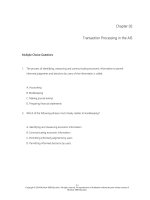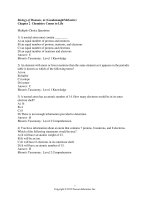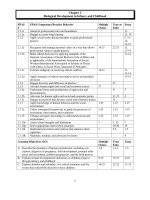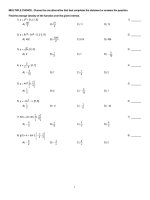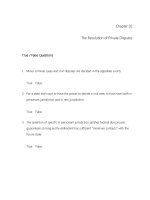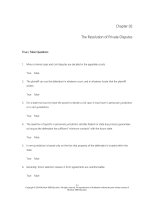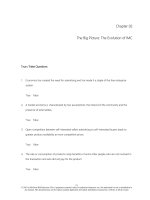Home and school relations teachers and parents working together 4th edition olsen test bank
Bạn đang xem bản rút gọn của tài liệu. Xem và tải ngay bản đầy đủ của tài liệu tại đây (734.28 KB, 17 trang )
Test Bank
for
Home and School Relations:
Teachers and Parents Working Together
Fourth Edition
Glenn Olsen
University of North Dakota
Mary Lou Fuller
University of North Dakota, Emeritus
Prepared by
Yuliya Kartoshkina
University of North Dakota
Angela Bell
University of North Dakota
Boston Columbus Indianapolis New York San Francisco Upper Saddle River
Amsterdam Cape Town Dubai London Madrid Milan Munich Paris Montreal Toronto
Delhi Mexico City Sao Paulo Sydney Hong Kong Seoul Singapore Taipei Tokyo
______________________________________________________________________________
Copyright © 2012, 2008, 2003 by Pearson Education, Inc., Upper Saddle River, New Jersey 07458.
All rights reserved. Printed in the United States of America. This publication is protected by Copyright and
permission should be obtained from the publisher prior to any prohibited reproduction, storage in a retrieval
system, or transmission in any form or by any means, electronic, mechanical, photocopying, recording, or
likewise. For information regarding permission(s), write to: Rights and Permissions Department.
Pearson® is a registered trademark of Pearson plc
Instructors of classes using Olsen and Fuller’s Home and School Relations: Teachers and Parents Working
Together, Fourth Edition, may reproduce material from the test bank for classroom use.
10 9 8 7 6 5 4 3 2 1
ISBN-10: 0132373416
ISBN-13: 9780132373418
www.pearsonhighered.com
ii
Table of Contents
Chapter 1: An Introduction to Families
1
Chapter 2: Families and Their Functions—Past and Present
3
Chapter 3: Family Diversity
6
Chapter 4: Parents’ Perspectives on Parenting
9
Chapter 5: Teachers and Parenting: Multiple Views
12
Chapter 6: Parent-Teacher Communication: Who’s Talking?
14
Chapter 7: Family Involvement in Education
17
Chapter 8: Families and Their Children with Disabilities
19
Chapter 9: Family Involvement Models
22
Chapter 10: Education Law and Parental Rights
25
Chapter 11: Family Violence: The Effect on Teachers, Parents, and Children
28
Chapter 12: Poverty: The Enemy of Children and Families
31
Chapter 13: Fathering, Schools, and Schooling:
What Fathers Contribute and Why It Is Important
33
Chapter 14: The Implications of Home–School Partnerships for
School Violence and Bullying
35
Chapter 15: Finding a Voice for Children for Children and Families:
Public Policy, Social Services, and Advocacy in Action
38
Answer Key
40
iii
CHAPTER 1
An Introduction to Families
True/False Questions
Circle T if the statement is true; circle F if the statement is false.
T F 1. Parents in all times and parents have been concerned about their children’s health,
nutrition, and safety.
T F 2. Parents are the only ones who are involved in the enculturation of their children.
T F 3. In the mid-1880s, the role of parents in the United States shifted from being
actively involved in running the school to being guests of the school.
Multiple Choice Questions
Circle the best answer.
4. What were the primary purposes of families in the past?
a. to prepare children by making sure that they went to school
b. to protect children from harm and prepare them to function within society
c. to make sure that children went to school and protect them
d. a & b
5. Which of the following has NOT changed over time?
a. The function of the family
b. The nature of the dangers children faced
c. The character of society
d. All of the above
6. The process by which a family and/or society prepares children to behave
appropriately and appreciate their cultural values and traditions is known as __________.
a. deculturation
b. enculturation
c. socialization
d. b & c
7. In what state were public schools initially legislated?
a. Massachusetts
b. New York
c. Pennsylvania
d. Ohio
8. If teachers’ professional efforts are to complement those of parents, they need to have
_______.
a. children of their own
ii
b. a better understanding of families
c. more education than the parents
d. lived in poverty
9. What changes related to the school took place in the mid-1880s when the United
States became more industrialized?
a. the influence of the individual parent on the school increased.
b. school districts decreased in size
c. the power shifted from administrators to the parents
d. the influence of the individual parent on the school decreased
10. Who had the primary role to interact with the school during the 1950s–70s?
a. Mothers
b. Fathers
c. Both mothers and fathers
d. Grandparents
11. What factor determines the quality of life for most families?
a. Income
b. Ethnicity
c. Family structure
d. Assimilation
12. Which is NOT a characteristic of the changing family structure?
a. The increase of single parent household headed by women
b. The increase in age of first time parents
c. The decrease in fathers who wish to be involved in parenting
d. The increase of fathers who are awarded custody after a divorce
Essay Questions
Give complete responses to each statement.
13. What are the effects of the changing economy on schools?
14. What is the primary purpose of the enculturation process?
15. How and why did the role of a teacher develop in a contemporary society?
16. Why do teachers need to have an understanding of families and how they function?
17. How are technological, societal, and demographic demands reflected in contemporary
families?
iii
CHAPTER 2
Families and Their Functions- Past and Present
True/False Questions
Circle T if the statement is true; circle F if the statement is false.
T F 1. The majority of families fit the stereotype of the “all-American family.”
T F 2. Only present-day families are struggling with problems resulting from political,
economic, and societal forces.
T F 3. The church had a tremendous influence on governmental matters, family life in
general, and child-rearing practices in Europe during the Middle Ages.
T F 4. Locke, an English philosopher, was the first one to introduce the idea that
children’s minds are like “clean slates” on which parents and teachers could write what
students were to learn.
T F 5. In 1912, the American government created the Children’s Bureau to address
concerns about undernourished, neglected, and abused children.
Multiple Choice Questions
Circle the best answer.
6. Parents of the past used their family values and functions to __________ and
_____________.
a. Earn money and spend time with family
b. Protect their children and prepare them for society
c. Protect their children from disease and educate them
d. Protect their children from starvation and educate them
7. With what conditions did pre-historical families deal?
a. Hunger, the elements, and disease
b. Clans, tribes, and other cultures
c. Starvation, lack of water, drought
d. None of the above
8.To protect their members against enemy tribes and to ensure that everyone had enough
to eat, pre-historical families:
a. Joined with other tribes to form clans
b. Made weapons and farmed
c. Were geographically isolated from others
d. Joined with other clans to form tribes
iv
9. Greek and Roman period families were concerned simply with surviving during the
Middle Ages (400-1400). Only ___________ were educated.
a. Noble boys
b. Noble girls
c. Peasant boys
d. Peasant girls
10. Which group believed that children were naturally evil and introduced the phrased,
“beat the devil out of the child?”
a. European Medieval families
b. Age of Reason families
c. Greek and Roman families
d. Pre-historical families
11. Martin Luther (1482-1546), the “father of Reformation,” proposed which
revolutionary child practice?
a. Beating the devil out of the child.
b. Education for boys and girls by their parents was good.
c. Education should be reserved for nobles.
d. Racial equality in schools was good.
12. Which German educator became known as the “father of Kindergarten”?
a. Rousseau
b. Pestalozzi
c. Froebel
d. Locke
13. The _________ emphasized ____________________________.
a. Industrial Revolution; human dignity
b. The Age of Darkness; Reformation
c. The Age of Reason; The Age of Darkness
d. The Age of Reason; human dignity
14. Which period is associated with child exploitation?
a. Industrial Revolution
b. Age of Reason
c. Period of Enlightenment
d. Colonial time in North America
15. During which period did approximately one-third of all marriages last only 10 years?
a. Industrial Revolution
b. Age of Reason
c. Period of Enlightenment
d. Colonial time in North America
v
Essay Questions
Give complete responses to each statement.
16. Why have attitudes towards children altered through time?
17. How and why did the Industrial Revolution change how children were treated?
18. How did the Great Depression and World War II affect the function of the family in
the United States?
19. What are the unique challenges contemporary families face in comparison with the
earlier times? Explain why those challenges are unique.
20. What is the difference between a functional and a dysfunctional family?
vi
Instructor’s Resource Manual
for
Home and School Relations:
Teachers and Parents Working Together
Fourth Edition
Glenn Olsen
University of North Dakota
Mary Lou Fuller
University of North Dakota, Emeritus
Prepared by:
Yuliya Kartoshkina
University of North Dakota
Boston Columbus Indianapolis New York San Francisco Upper Saddle River
Amsterdam Cape Town Dubai London Madrid Milan Munich Paris Montreal Toronto
Delhi Mexico City Sao Paulo Sydney Hong Kong Seoul Singapore Taipei Tokyo
vii
______________________________________________________________________________
Copyright © 2012, 2008, 2003 by Pearson Education, Inc., Upper Saddle River, New Jersey 07458.
All rights reserved. Printed in the United States of America. This publication is protected by Copyright and
permission should be obtained from the publisher prior to any prohibited reproduction, storage in a retrieval system,
or transmission in any form or by any means, electronic, mechanical, photocopying, recording, or likewise. For
information regarding permission(s), write to: Rights and Permissions Department.
Pearson® is a registered trademark of Pearson plc
Instructors of classes using Olsen and Fuller’s Home and School Relations: Teachers and Parents Working
Together, 4e, may reproduce material from the instructor’s manual for classroom use.
10 9 8 7 6 5 4 3 2 1
ISBN-10: 0132373408
ISBN-13: 9780132373401
www.pearsonhighered.com
ii
Introduction
Dear Colleagues,
This Online Instructor’s Resource Manual is designed to provide you with a set of
supplementary teaching aids to enrich and enhance your use of the textbook Home and School
Relations: Teachers and Parents Working Together, 4th edition.
Each chapter includes the following materials: a summary, learning objectives, important
concepts, ideas on how to review material from the previous chapter, ideas on how to introduce a
new chapter, and ideas for homework assignments.
By incorporating some of the manual’s instructional features and teaching suggestions in the
classroom, you may deepen students’ knowledge and understanding of how to:
Establish and maintain positive collaborative relationships with families
Acknowledge that parents are the child’s first teachers
Affirm and respect parents’ choices and goals for their child
Learn how to communicate effectively with parents about the school’s goals and their
child’s progress
Involve families in assessing and planning for individual children, including children
with disabilities, developmental delays or special needs
Involve parents in making decisions related to their child’s development and
understand how to involve children’s families in educational experiences
Accept differences in families and in their social and cultural backgrounds
Apply family systems theories and knowledge of dynamics of roles and relationships
within families and communities
Provide families with information regarding a range of family-oriented services
designed to help families’ identified needs
Communicate effectively with other professionals and agencies that support
children’s development, learning and well-being
Conduct effective parent teacher conferences and communicate well with parents
We are very thankful to Michael Gallo and Laurie Guy, instructors of the Home-School
Relations course at the University of North Dakota, as well as authors of the textbook chapters
for contributing the materials for this manual.
We hope you find the manual helpful and inspiring.
Yuliya Kartoshkina
University of North Dakota
Glenn Olsen
University of North Dakota
iii
Table of Contents
Chapter 1: An Introduction to Families
1
Chapter 2: Families and Their Functions—Past and Present
3
Chapter 3: Family Diversity
5
Chapter 4: Parents’ Perspectives on Parenting
8
Chapter 5: Teachers and Parenting: Multiple Views
10
Chapter 6: Parent-Teacher Communication: Who’s Talking?
12
Chapter 7: Family Involvement in Education
15
Chapter 8: Families and Their Children with Disabilities
17
Chapter 9: Family Involvement Models
19
Chapter 10: Education Law and Parental Rights
22
Chapter 11: Family Violence: The Effect on Teachers, Parents, and Children
25
Chapter 12: Poverty: The Enemy of Children and Families
28
Chapter 13: Fathering, Schools, and Schooling: What Fathers Contribute and Why It Is
Important
31
Chapter 14: The Implications of Home–School Partnerships for School Violence and Bullying 33
Chapter 15: Finding a Voice for Children for Children and Families: Public Policy, Social
Services and Advocacy in Action
iv
36
Chapter 1
An Introduction to Families
Summary: Chapter 1 provides background information on families, their purposes, needs,
behaviors, diverse backgrounds and changes over time.
Learning objectives:
Review historical perspectives on family and home-school relations
Understand the purpose, responsibilities and behaviors of families
Identify teacher’s role in interacting with families
At the end of this chapter, students will master the following concepts:
- Family (past and present perspectives)
- Family responsibilities
- Home-school relations (past and present perspectives)
- Parent involvement
Ideas for Introducing Chapter 1
1) Introduction activity: Think, pair, share
Ask students to think about who they are and find a partner to exchange their
perspectives on this topic. Later, ask how many of them have references to family in their
answers.
2) Introductory activity: School memories
Ask students to reflect on their school memories by asking them the following:
Looking back at elementary school, what things have changed about education by the
time you were a junior or senior in high school? Why?
What positive and negative things happened in your K-12 education experience?
3) Peer discussion: (Text, p.1)
Ask students to work with a peer and ask each other the following questions:
- What is the purpose and behavior of families?
- What are vital roles of families?
- What is the teacher’s role?
- What were home-school relations of the past?
- How are families changing?
Whole class discussion:
- Why should we consider these objectives on page 1 in your textbook?
- What new objectives could you add to this list?
4) Group discussion: What is family?
Ask students to do the following:
- Share your thoughts on the complexities of today’s families.
- Brainstorm “famous” or “TV” families and list their characteristics.
5
-
Compare or contrast your perspective to the “famous” or “TV” families.
5) Discussion: Looking at families and their responsibilities
Ask students to discuss the following questions:
- What are the most important things that families do for children?
- What important lessons did you learn from your family?
- How have home-school relations been changing through time?
- What factors influence families? Why? (p. 6)
6) Case Study Application of Concepts (p. 10)
Ask students to read a case study on p. 6 and discuss the questions:
1. How does Jordan’s life differ from that of his father when he was a child?
2. What are the strengths in Jordan’s family structure?
3. What are some potentially problematic areas?
Ideas for Homework Assignments
1) Website exploration
Go to Family Facts organization website (www.familyfacts.org). It provides data on
family and analysis of its role in maintaining civil society in the United States. Choose
one study, read about it, and bring your thoughts about the study to talk about in class.
2) Reading a children’s book
Choose one of the books mentioned on p. 12, read it, and write several paragraphs on
how this book is connected to the issues discussed in Chapter 1. Bring the book to the
following class to read excerpts from the book to illustrate your points.
3) Interview
Interview a parent, sibling or extended family member. Write a 2-3 page paper and
include the following:
- The history of your family
- The structures and needs of your contemporary family compared to your family’s
history
- Thoughts of your parents and grandparents about school
Bring artifacts or mementos that would best describe the unique attributes of your family
to share with class.
6
Chapter 2
Families and Their Functions- Past and Present
Summary: Chapter 2 provides the background information on the historical development of the
family and reviews problems and challenges contemporary families are facing.
Learning objectives:
Trace the history of the family
Identify the structures and needs of the contemporary family
Compare historical and contemporary families
Describe functional and dysfunctional families
At the end of this chapter, students will master the following important concepts:
- Functional family
- Dysfunctional family
- Divorce
- Stigmatization
- Single-parent families
- Blended families
Ideas for Review Chapter 1
1) Questions for review
- What have perspectives on family and relations between home and school been changing
over time?
- What are the purpose, responsibilities and behaviors of families?
- What is a teacher’s role in interacting with families?
2) Discussion of homework assignment (Interview)
Divide students in small groups students and ask them to discuss the following:
- Compare your families, their structures, and needs
- Share your artifacts, if available
- Compare how your parents and grandparents thought about school
- Identify elements of functional and dysfunctional families based on your interview
Whole Class discussion:
- What were major differences and similiaries when you compared your families?
- Why do you think those differences exist?
- Why do you think those similarities exist?
3) Discussion of homework assignment (Website exploration)
Divide students in small groups and ask them to discuss their studies from the website
and what they learned about them. They can share their major learning outcomes with the
class.
4) Discussion of homework assignment (A children’s book)
Divide students in small groups and ask them to discuss how the book they chose connect
7
to the material covered in Chapter 1. They can read some excerpts from the book to
illustrate their points.
Ideas for Introducing Chapter 2
5) Questions for Discussion: Historical timeline
- Why is it necessary to review a historical perspective on families?
- Why would we think about families from other eras the way we think about families from
different cultures?
- What can we learn from families in the past?
6) Visual Mindmapping: Families from different historical periods (pp. 14-22)
Have students work in small groups. Give each group a historical period from the
textbook. Students will create a visual mind map of the given historical period and
hightlight following:
- Identify the challenges and the benefits for families living during that time
- Compare their challenges and the benefits with contemporary families
At the end of the assignment, students will draw their mind maps on the board and
present them to the class.
To learn more about mindmaps, go to
/>7)
-
Discusion questions: Contemporary U.S. families (pp. 22-31)
What familial structures of contemporary U.S. families can you name?
Why are single-parent families so common in the contemporary U.S.?
How can you as a teacher avoid stigmatization of children whose parents got divorced?
What are the most common myths about blended families? Why do those myths exist?
8) Brainstorming exercise
In small group students will brainstorm what dysfunctional families need to do to become
functional. The whole class discussion will follow to compare the ideas.
Ideas for Homework Assignments
1) Research Paper: Going Back in Time
Choose a historical time period from the textbook and write a short research paper on
what it would be like living at that time and having a family. Address the following:
- What challenges might you face as parents and why?
- How could you possibly overcome those challenges?
2) Collage: Functional and dysfunctional families
Examine popular magazines. Cut out pictures and words (nouns and adjectives) that
would represent functional and dysfunctional families. Create two collages to represent
two types of those families.
8
